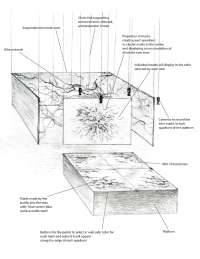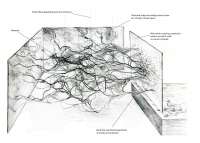Sara Schnadt Connectivity II - Project Concept In this revolutionary moment, online tools are as dynamic as their implications for fundamentally changing information reception. As a technologist who also develops online artist resources, I am part of a national dialog of innovators. As a performance artist, I illustrate my privileged vantage point using ordinary materials (with a metaphorical relationship to technology) in extraordinary ways. For Connectivity, at the MCA Chicago in 2007, I 'built the Internet' as a month-long performance using donated, multi-colored wool, twine and wire. The resulting installation was lush, intricate and epic. An adjacent 4-by-7-foot dance platform made of hundreds of tiny metal nuts provided a space for tracing online research pathways. The nuts also attracted the public, who drew and wrote in them. Connectivity II extends the visual and interactive effect of the nuts field by increasing its dimensions and recording all mark-making. These recorded marks will display cumulatively as a projection and serve as a score for the evolving structure of the network that is built from the back surface of a projection screen into an adjacent space. Using multi-colored buttons at the edges of the nuts platform, the public will color code their marks as discreet contributions into the system. The adjacent space will be created with 3 suspended mirrored partial walls surrounding the back of the projection screen. As the network is built into this mirrored space in colors corresponding to the projected marks, the illusion of an infinite network will be created. Since the walls are partial, however, the public will register this infinite 'virtual' space within the ordinary space of the room itself. This effect will become more dramatic over the course of the exhibit as marks accumulate on the projection, and regular performances evolve the network. To emphasize the 'DIY' ethos of Web 2.0, ordinary building materials such as chip board, mirrored tile, wire and colored tape in 'web safe' colors, ordinary metal nuts, and garden grade wire mesh will comprise the physical structures of the piece. While these ordinary materials will keep the audience grounded in the real space they experience in everyday life, the visual illusion of infinite networked space generated by their contributions will remind viewers that we simultaneously exist in an infinite and dynamic virtual space whose constant evolution we contribute to each day.
Sara Schnadt Connectivity II - Project Concept In this revolutionary moment, online tools are as dynamic as their implications for fundamentally changing information reception. As a technologist who also develops online artist resources, I am part of a national dialog of innovators. As a performance artist, I illustrate my privileged vantage point using ordinary materials (with a metaphorical relationship to technology) in extraordinary ways. For Connectivity, at the MCA Chicago in 2007, I 'built the Internet' as a month-long performance using donated, multi-colored wool, twine and wire. The resulting installation was lush, intricate and epic. An adjacent 4-by-7-foot dance platform made of hundreds of tiny metal nuts provided a space for tracing online research pathways. The nuts also attracted the public, who drew and wrote in them. Connectivity II extends the visual and interactive effect of the nuts field by increasing its dimensions and recording all mark-making. These recorded marks will display cumulatively as a projection and serve as a score for the evolving structure of the network that is built from the back surface of a projection screen into an adjacent space. Using multi-colored buttons at the edges of the nuts platform, the public will color code their marks as discreet contributions into the system. The adjacent space will be created with 3 suspended mirrored partial walls surrounding the back of the projection screen. As the network is built into this mirrored space in colors corresponding to the projected marks, the illusion of an infinite network will be created. Since the walls are partial, however, the public will register this infinite 'virtual' space within the ordinary space of the room itself. This effect will become more dramatic over the course of the exhibit as marks accumulate on the projection, and regular performances evolve the network. To emphasize the 'DIY' ethos of Web 2.0, ordinary building materials such as chip board, mirrored tile, wire and colored tape in 'web safe' colors, ordinary metal nuts, and garden grade wire mesh will comprise the physical structures of the piece. While these ordinary materials will keep the audience grounded in the real space they experience in everyday life, the visual illusion of infinite networked space generated by their contributions will remind viewers that we simultaneously exist in an infinite and dynamic virtual space whose constant evolution we contribute to each day.

